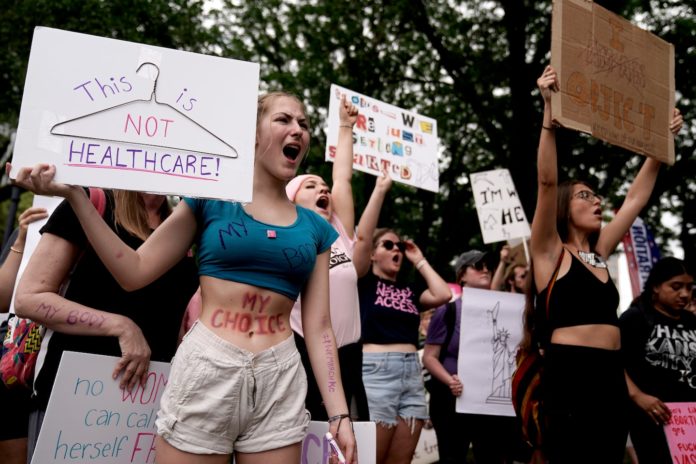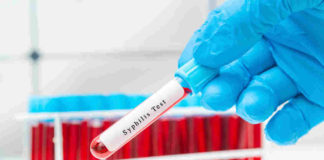
That’s because those 17 states also all have dangerous HIV statutes on their books that either criminalize or regulate acts that may expose someone to HIV. These laws are steeped in nonscientific and outdated understandings of HIV and disproportionately target communities of color. Frequently, they are disingenuously passed as measures that protect women, while specifically targeting sex workers.
While the two areas of policy are often different, both have a shared effect: They make it harder for poor, marginalized women to access basic health care. Tracing their overlapping histories can therefore help guide the abortion rights movement moving forward.
Abortion rights activists seeking to legally challenge the trigger bans in these states can learn from the recent successes of HIV groups like Colorado’s Positive Women’s Network and its allies. In 2018, they successfully overhauled punitive laws targeting HIV-positive sex workers. Positive Women’s Network’s success is part of a longer history of activism by HIV-positive women, such as Carla Abbotts, whose story sits at the intersection of HIV and reproductive rights. Abbotts recognized that activism in both areas was crucial to securing basic health care for women. Her activism can help guide today’s efforts to dismantle draconian laws and inform future coalitions.
Originally from New Jersey, Abbotts was working as a bookkeeper in San Francisco in the 1980s. She socialized with the artistic sex-positive alternative underground subculture thriving in the city, which included comic artists and DJs. A former IV-drug user, Abbotts’s recovery journey led her to being active in the support group Narcotics Anonymous. Her first brush with activism was suing the Free Pregnancy Center, a San Francisco crisis center, in 1986. Her lawsuit became part of a larger challenge to pregnancy crisis centers by feminist activists, and her story was covered in newspapers and magazines across the United States. Abbotts launched her lawsuit shortly before her own HIV diagnosis.
Abbotts then told parts of her story in her own voice in San Francisco’s alternative underground art scene and nightlife. She collaborated with artist Dori Seda for a 1987 comic anthology issue titled, “Door of Deception … or Right to Lie.” In the autobiographical comic, Abbotts, suspecting she is pregnant, finds the Free Pregnancy Center in the San Francisco Yellow Pages, where it is advertised as a walk-in clinic providing free pregnancy tests and birth control. She makes an appointment and, upon arrival in her best clothes with a container of urine ready for her test, the thought bubble over her head reads, “For the worst, I decided to look my best.”
The comic reflected the real-world encounter she had at this center. Unknown to Abbotts, the center had a reputation for misleading young women about their health-care options. Abbotts recalled the first sign of trouble when the clinic nurse asked about her religious background. After the pregnancy test, the nurse insisted she watch a slide show while waiting for her results. The slides featured images of a trash can piled high with dead fetuses, women fatally injured by their abortions and dying by suicide afterward. Furious, Abbotts shut off the projector and told the bewildered nurse, “You’re lucky I didn’t throw it out the window!”
After Abbotts learned she was pregnant, the nurse proceeded to pressure her about adoption. Abbotts stormed out of the clinic and went to the Better Business Bureau to find a way to put a stop to the way the clinic was misleading women seeking abortion services. She was linked up with a feminist lawyer who helped file suit and Abbotts eventually got access to the abortion and care she needed.
Her lawsuit targeted the center and its funder, the Pearson Foundation. Through the Committee to Defend Reproductive Rights, the lawsuit successfully barred the pregnancy center from falsely advertising itself and limited the Pearson Foundation’s ability to fund such clinics. Abbotts confessed, “I never thought I’d end up doing something like this!”
By then, however, she was dealing with AIDS and declining health. In the late 1980s, AZT was the only available treatment for HIV. Her doctor suggested she join the Phase I Dextran Sulfate trials. A few years later, she also enrolled in the Phase 1 CD-4 clinical trials. Abbotts counted herself lucky to be on both trials even as the results proved disheartening.
Abbotts was the only HIV-positive woman enrolled in both clinical trials. The gay men she met while undergoing the trials were well networked with services and care. At this time, San Francisco’s HIV/AIDS care served gay men almost exclusively. It was often justified by noting there were so few positive women in the city. Many doctors did not understand, however, that AIDS manifested differently with women. Additionally, HIV-positive women had only one support group that was specifically for them in the late 1980s.
Abbotts grew increasingly frustrated with the power struggles with her doctors over her treatments. Dextran made her sicker and the doctors at first ignored her complaints. CD-4 initially boosted her energy but quickly proved to be ineffective. She also had to find a new primary-care provider every time a trial ended.
But Abbotts’s connections to gay men, and her observations about the disparities in care, gave her the motivation to create health-care support for HIV-positive women. She joined the Women’s AIDS Network and became one of the first HIV-positive women to serve on its board. She began speaking publicly and sharing her experiences as an HIV-positive woman more frequently.
Activists, namely those involved with the direct-action group Act Up, helped fight for HIV-positive women to be recognized by the Centers for Disease Control and Prevention and included on trials beginning in the late 1980s. But Abbotts used her own experience to raise even more questions about the inequities of access and treatment, and helped push AIDS activists to think broadly about health care. She forced them to ask: How much good could clinical trials even do if women’s basic health-care needs weren’t met to begin with?
“Before you can even think about a clinical trial,” Abbotts wrote to her fellow HIV-positive women, “the basics need to be met. They must not take the place of a woman’s primary care.”
Her health stabilized as her trials — both the lawsuit and the clinical ones — concluded. But it wasn’t from the treatments. Abbotts saw the importance of getting women information about their health — whether it be about abortion or HIV. She worked hard to get women the necessary information about their bodies to help make the best life decisions for themselves. Abbotts continued to advocate for herself and other HIV-positive women until her death in 1999 at age 40.
Abbotts’s story sheds light on how HIV-positive women advocated for themselves when they were often ignored. Even today, HIV-positive women, particularly women of color, continue to be underrepresented in clinical trials. Alongside HIV criminalization bills, these women risk further marginalization and less access to health care due to antiabortion laws.
Activists like Abbotts, who bridged their experiences of reproductive health with conversations around HIV care, show us how these ideas touch on some of the same areas and affect overlapping populations. As such, efforts to expand access to abortion will achieve more if they address the larger arena of health care for women and other people with uteruses — whether they are HIV-positive or negative.








